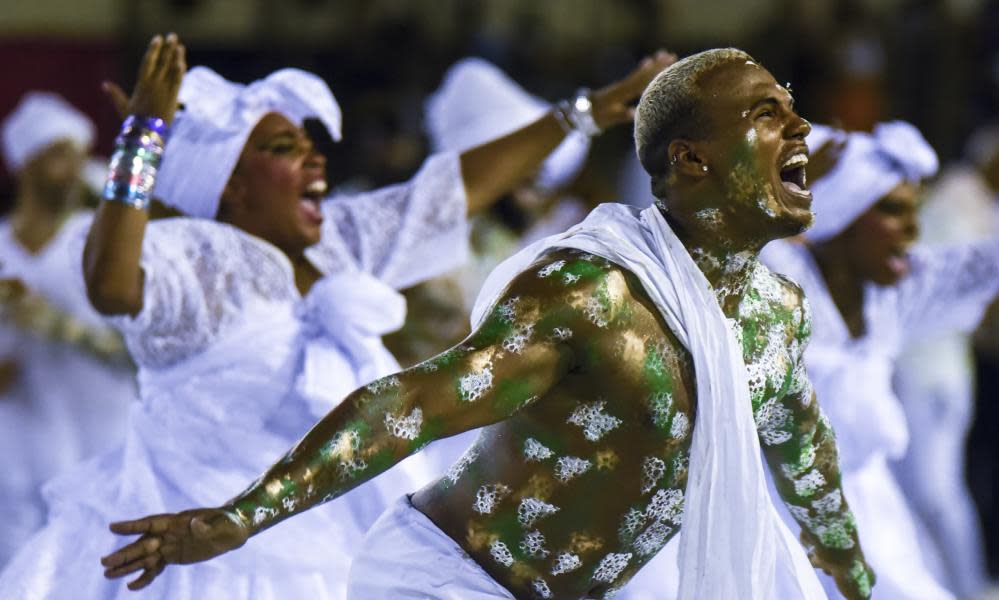‘Carnival of democracy’: celebration returns to Rio after a two-year hiatus

In Rio de Janeiro, the saying goes that carnival begins right after the New Year.
So, since last month, exuberant Cariocas dressed in their sparkliest and skimpiest outfits have sambaed through the city’s historical centre to the sound of percussion and brass bands, lured to the streets as the blocos – musical troupes that lead the street parties – proclaim the unofficial launch of carnival.
“I feel ecstatic,” said Juliana Santos, a 41-year-old vocal therapist who on a recent weekend set out dressed as the Queen of Hearts for a day chasing blocos.
The atmosphere is particularly feverish this year, after the coronavirus pandemic forced a two-year hiatus that took an economic and emotional toll on Rio and its carnival-starved residents.
Related: ‘No greater triumph’: excitement builds in Rio for carnival’s return
Although out-of-season samba parades were held last year, the street celebrations were restricted to a smattering of rebellious blocos that defied a ban on the free gatherings.
Now, the pre-Lenten revelry is finally back in all its glory.
“Having people back on the streets, occupying public space again, really occupying it again, it’s fundamental. Carnival is the street,” said Rafael Dummar, 41, a professional musician who played the banjo in an unofficial bloco that set off from the hillside neighbourhood of Santa Teresa on Saturday.
Officially, more than 450 blocos have permission to roam the streets between late January and late February for what the mayor of Rio, Eduardo Paes, has declared will be a “carnival of democracy”.
But the main attraction of the pre-carnival period are the scores of unofficial groups organised over WhatsApp and Instagram such as the procession in Santa Teresa that went by the nonsensical name of “Paralelepípedo de Itaquaquecetuba”.
“Traditional, authorised blocos are the principal pillars of street carnival, of course, but this spontaneous carnival – sometimes called alternative carnival, unofficial carnival – is essential,” said Raphael Pavan, a self-confessed carnival enthusiast who co-organised one such spontaneous bloco creatively christened “Geleia da Shakira” (Shakira’s Jam) – a nod to the online frenzy surrounding the Colombian star’s diss track about her ex and rumours she used a jar of jam to catch him cheating.
“This playfulness, this irreverence, is typical of the Carioca carnival,” said the 35-year-old advertising professional and occasional saxophonist.
If Rio’s carefully choreographed samba school parades are considered by many the greatest show on earth, the city’s irreverent and riotous street carnival is “the greatest ritual on earth”, according to Raquel Potí, a familiar face at carnival who helped introduce the now ubiquitous stilt walkers into bloco culture.
“Carnival brings people together on the same wavelength of joy and celebration, transforming Brazilians’ often tough daily reality in a poetic, playful way,” said the 39-year-old artist. “I believe carnival has a curative, transformative power,” she added.
Brazil is certainly in need of a restorative overhaul after the devastating four years of Jair Bolsonaro’s far-right presidency. The creative sector suffered hugely, as Bolsonaro’s disdain for Brazilian culture trickled down into policy. His government got rid of the culture ministry, slashed funding for the arts and was even accused of censorship.
Carnival took a hit too, especially in Rio under Paes’s predecessor as mayor, Marcelo Crivella, a Bolsonaro-supporting neo-Pentecostal bishop who was at best indifferent to the cultural extravaganza many consider a part of the city’s identity.
“A lot of what we [blocos] achieved over the past 10, 15 years, was lost under the last government,” said Potí. “We’re returning to the street carnival with a lot of challenges.”
President Luiz Inácio Lula da Silva is no panacea for Brazil’s problems but, one month into his third term, he has at the very least infused the country with a breath of optimism.

As the unpronounceable Santa Teresa bloco wound its way down a cobbled street overlooking Guanabara Bay, a handful of carnival-goers broke into a chant celebrating the leftist leader: “Olé, olé, olé olá, Lula.”
As if on cue, the musicians started playing Ai Que Saudade d’Ocê (Oh How I Miss You), a baião tune by the north-eastern composer Vital Farias.
“These past few years, carnival had really become an escape valve … This year, so far, I see a less critical, more hopeful tone,” said Pavan, the saxophonist.
Dummar, who has played in blocos for 25 years, is not so sure. As revellers romped through the streets of Rio celebrating the return of a two-month-long carnival in early January, far-right extremists were ransacking government headquarters in Brasília in an unprecedented assault on Brazil’s young democracy.
“We’re still trying to escape, aren’t we,” said the musician, before shouldering his banjo and heading off to the next bloco.

 Yahoo Movies
Yahoo Movies 
